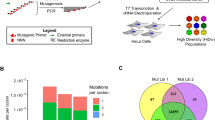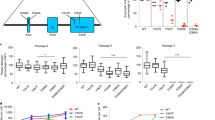Abstract
Mutational analysis of the viral genome is frequently used to study the role of sequence or structural elements in HIV-1 replication. Many laboratories that use this approach have occasionally come across revertant viruses that overcome an introduced defect either by restoration of the original sequence or by the introduction of additional mutations in the viral genome. Similarly, replication of a wild type virus under selective pressure, due to the presence of inhibitors or due to specific culture settings, may result in the appearance of evolved variants that replicate more efficiently under the applied conditions. We have developed in vitro HIV-1 evolution from an anecdotal event to a systematic research tool to study different aspects of the viral replication cycle. In this manuscript, we will briefly review the method of forced virus evolution to study HIV-1 biology and provide several examples that illustrate the power of this method, as it frequently yielded interesting and unexpected information about the mechanism of virus replication.
Access this chapter
Tax calculation will be finalised at checkout
Purchases are for personal use only
Similar content being viewed by others
References
Berkhout, B., Das, A. T., Beerens, N. (2001) HIV-1 RNA editing, hypermutation and error-prone reverse transcription. Science 292, 7.
Berkhout, B., de Ronde, A. (2004) APOB-EC3G versus reverse transcriptase in the generation of HIV-1 drug-resistance mutations. AIDS 18, 1861–1863.
Coffin, J. M. (1995) HIV population dynamics in vivo: implications for genetic variation, pathogenesis, and therapy. Science 267, 483–489.
Keulen, W., Boucher, C., Berkhout, B. (1996) Nucleotide substitution patterns can predict the requirements for drug-resistance of HIV-1 proteins. Antiviral Res 31, 45–57.
Lacey, S. F., Larder, B. A. (1994) Mutagenic study of codons 74 and 215 of the human immunodeficiency virus type 1 reverse transcriptase, which are significant in nucleoside analog resistance. J Virol 5, 3421–3424.
Das, A. T., Klaver, B., Berkhout, B. (1995) Reduced replication of human immunodeficiency virus type 1 mutants that use reverse transcription primers other than the natural tRNA(3Lys). J Virol 69, 3090–3097.
Keulen, W., Back, N. K. T., van Wijk, A., et al. (1997) Initial appearance of the 184Ile variant in lamivudine-treated patients is caused by the mutational bias of the human immunodeficiency virus type 1 Reverse Transcriptase. J Virol 71, 3346–3350.
Back, N. K. T., Nijhuis, M., Keulen, W., et al. (1996) Reduced replication of 3TC-resistant HIV-1 variants in primary cells due to a processivity defect of the reverse transcriptase enzyme. EMBO J 15, 4040–4049.
Breaker, R. R. (2004) Natural and engineered nucleic acids as tools to explore biology. Nature 432, 838–845.
Berkhout, B., Klaver, B. (1993) In vivo selection of randomly mutated retroviral genomes. Nucleic Acids Res 21, 5020–5024.
Morris, S., Johnson, M., Stavnezer, E., et al. (2002) Replication of avian sarcoma virus in vivo requires an interaction between the viral RNA and the TpsiC loop of the tRNA(Trp) primer. J Virol 76, 7571–7577.
Doria-Rose, N. A., Vogt, V. M. (1998) In vivo selection of Rous sarcoma virus mutants with randomized sequences in the packaging signal. J Virol 72, 8073–8082.
Rieger, A., Nassal, M. (1995) Distinct requirements for primary sequence in the 5′- and 3′-part of a bulge in the hepatitis B virus RNA encapsidation signal revealed by a combination in vivo selection/in vitro amplification system. Nucleic Acids Res 23, 3909–3915.
Sun, X., Zhang, G., Simon, A. E. (2005) Short internal sequences involved in replication and virion accumulation in a subviral RNA of turnip crinkle virus. J Virol 79, 512–524.
Zhang, J., Simon, A. E. (2005) Importance of sequence and structural elements within a viral replication repressor. Virology 333, 301–315.
Yoon, M., Spear, P. G. (2004) Random mutagenesis of the gene encoding a viral ligand for multiple cell entry receptors to obtain viral mutants altered for receptor usage. Proc Natl Acad Sci USA 101, 17252–17257.
Das, A. T., Brummelkamp, T. R., Westerhout, E. M., et al. (2004) Human immunodeficiency virus type 1 escapes from RNA interference-mediated inhibition. J Virol 78, 2601–2605.
Westerhout, E. M., Ooms, M., Vink, M., et al. (2005) HIV-1 can escape from RNA interference by evolving an alternative structure in its RNA genome. Nucleic Acids Res 33, 796–804.
Verhoef, K., Berkhout, B. (1999) A second-site mutation that restores replication of a Tat-defective human immunodeficiency virus. J Virol 73, 2781–2789.
Das, A. T., van Dam, A. P., Klaver, B., et al. (1998) Improved envelope function selected by long-term cultivation of a translation-impaired HIV-1 mutant. Virology 244, 552–562.
Das, A. T., Land, A., Braakman, I., et al. (1999) HIV-1 evolves into a non-syncytium-inducing virus upon prolonged culture in vitro. Virology 263, 55–69.
Baldwin, C. E., Berkhout, B. (2006) Second site escape of a T20-dependent HIV-1 variant by a single amino acid change in the CD4 binding region of the envelope glycoprotein. Retrovirology 3, 84.
Licis, N., Balklava, Z., van Duin, J. (2000) Forced retroevolution of an RNA bacteriophage. Virology 271, 298–306.
Klovins, J., Tsareva, N. A., de Smit, M. H., et al. (1997) Rapid evolution of translational control mechanisms in RNA genomes. J Mol Biol 265, 372–384.
Olsthoorn, R. C. L., van Duin, J. (1996) Evolutionary reconstruction of a hairpin deleted from the genome of an RNA virus. Proc Natl Acad Sci USA 93, 12256–12261.
Huthoff, H., Berkhout, B. (2001) Two alternating structures for the HIV-1 leader RNA. RNA 7, 143–157.
Berkhout, B., Klaver, B., Das, A. T. (1997) Forced evolution of a regulatory RNA helix in the HIV-1 genome. Nucleic Acids Res 25, 940–947.
Konstantinova, P., de Haan, P., Das, A. T., et al. (2006) Hairpin-induced tRNA-mediated (HITME) recombination in HIV-1. Nucleic Acids Res 34, 2206–2218.
van der Hoek L., Back, N., Jebbink, M. F., et al. (2005) Increased multinucleoside drug resistance and decreased replicative capacity of a human immunodeficiency virus type 1 variant with an 8-amino-Acid insert in the reverse transcriptase. J Virol 79, 3536–3543.
Takebe, Y., Telesnitsky, A. (2006) Evidence for the acquisition of multi-drug resistance in an HIV-1 clinical isolate via human sequence transduction. Virology 351, 1–6.
Mills, J., Desrosiers, R., Rud, E., et al. (2000) Live attenuated HIV vaccines: proposal for further research and development. AIDS Res Hum Retroviruses 16, 1453–1461.
Baba, T. W., Liska, V., Khimani, A. H., et al. (1999) Live attenuated, multiply deleted simian immunodeficiency virus causes AIDS in infant and adult macaques. Nat Med 5, 194–203.
Berkhout, B., Verhoef, K., van Wamel, J. L., et al. (1999) Genetic instability of live, attenuated human immunodeficiency virus type 1 vaccine strains. J Virol 73, 1138–1145.
Marzio, G., Verhoef, K., Vink, M., et al. (2001) In vitro evolution of a highly replicating, doxycycline-dependent HIV for applications in vaccine studies. Proc Natl Acad Sci USA 98, 6342–6347.
Verhoef, K., Marzio, G., Hillen, W., et al. (2001) Strict control of human immunodeficiency virus type 1 replication by a genetic switch: Tet for Tat. J Virol 75, 979–987.
Marzio, G., Vink, M., Verhoef, K., et al. (2002) Efficient human immunodeficiency virus replication requires a fine-tuned level of transcription. J Virol 76, 3084–3088.
Das, A. T., Zhou, X., Vink, M., et al. (2004) Viral evolution as a tool to improve the tetracycline-regulated gene expression system. J Biol Chem 279, 18776–18782.
Zhou, X., Vink, M., Klaver, B., et al. (2006) Optimization of the Tet-On system for regulated gene expression through viral evolution. Gene Ther 13, 1382–1390.
Zhou, X., Symons, J., Hoppes, R., et al. (2007) Improved single-chain transactivators of the Tet-On gene expression system. BMC Biotechnol 7, 6.
Zhou, X., Vink, M., Klaver, B., et al. (2006) The genetic stability of a conditional-live HIV-1 variant can be improved by mutations in the Tet-On regulatory system that restrain evolution. J Biol Chem 281, 17084–17091.
Zhou, X., Vink, M., Berkhout, B., et al. (2006) Modification of the Tet-On regulatory system prevents the conditional-live HIV-1 variant from losing doxycycline-control. Retrovirology 3, 82.
Churchill, M. J., Rhodes, D. I., Learmont, J. C., et al. (2006) Longitudinal analysis of human immunodeficiency virus type 1 nef/long terminal repeat sequences in a cohort of long-term survivors infected from a single source. J Virol 80, 1047–1052.
Huthoff, H., Das, A. T., Vink, M., et al. (2004) A human immunodeficiency virus type 1-infected individual with low viral load harbors a virus variant that exhibits an in vitro RNA dimerization defect. J Virol 78, 4907–4913.
Author information
Authors and Affiliations
Editor information
Editors and Affiliations
Rights and permissions
Copyright information
© 2009 Humana Press, a part of Springer Science+Business Media, LLC
About this protocol
Cite this protocol
Berkhout, B., Das, A.T. (2009). Virus Evolution as a Tool to Study HIV-1 Biology. In: Prasad, V.R., Kalpana, G.V. (eds) HIV Protocols. Methods In Molecular Biology™, vol 485. Humana Press. https://doi.org/10.1007/978-1-59745-170-3_30
Download citation
DOI: https://doi.org/10.1007/978-1-59745-170-3_30
Publisher Name: Humana Press
Print ISBN: 978-1-58829-859-1
Online ISBN: 978-1-59745-170-3
eBook Packages: Springer Protocols




